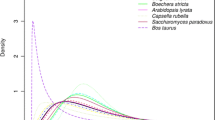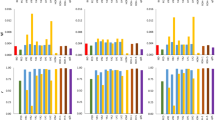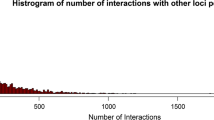Abstract
In livestock populations, fitness may decrease due to inbreeding depression or as a negatively correlated response to artificial selection. On the other hand, fitness may increase due to natural selection. In the absence of a correlated response due to artificial selection, the critical population size at which the increase due to natural selection and the decrease due to inbreeding depression balance each other is approximately D/2σwa 2, where D=the inbreeding depression of fitness with complete inbreeding, and σwa 2=the additive genetic variance of fitness. This simple expression agrees well with results from transmission probability matrix methods. If fitness declines as a correlated negative response to artificial selection, then a large increase in the critical effective population size is needed. However, if the negative response is larger than the response to natural selection, a reduction in fitness cannot be prevented. From these results it is concluded that a negative correlation between artificial and natural selection should be avoided. Effective sizes to prevent a decline in fitness are usually larger than those which maximize genetic gain of overall efficiency, i.e., the former is a more stringent restriction on effective size. In the examples presented, effective sizes ranged from 31 to 250 animals per generation.
Similar content being viewed by others
References
Abplanalp H, Peterson SJ, Okamoto S, Napolitano D (1984) Heterosis, recombination effects and genetic variation of egg composition in inbred lines of White Leghorns and their crosses. Br Poultry Sci 25:361–367
Beilharz RG (1982) The effect of inbreeding on reproduction in mice. Anim Prod 34:49–54
Bulmer MG (1971) The effect of selection on genetic variability. The Am Nat 105:201–211
Cunningham CP, Moen RA, Gjedren T (1970) Restriction of selection indices. Biometrics 26:67–70
Fairfull RW, Gowe RS, Nagai J (1987) Dominance and epistasis in heterosis of White Leghorns strain crosses. Can J Anim Sci 67:663–680
Falconer DS (1981) Introduction to quantitative genetics. Oliver and Boyd, Longman, London
Fisher RA (1929) The genetical theory of natural selection. Dover Publications, New York
Frankham R (1990) Are responses to artificial selection for reproductive fitness characters consistently asymmetrical? Genet Res 56:35–42
Frankham R, Yoo BH, Sheldon BL (1988) Reproductive fitness and artificial selection in animal breeding: culling on fitness prevents a decline in reproductive fitness in lines of Drosophila melanogaster selected for increased inebriation time. Theor Appl Genet 76:909–914
Franklin IR (1980) Evolutionary change in small populations. In: Soulé ME, Wilcox BA (eds) Conservation biology: an evolutionary-ecological perspective. Sinauer Associates, Sunderland, Mass., 135–150
Gillois M (1964) La relation d'identité en génétique. Thesis, University of Paris
Gibson JP, Kennedy BW (1990) The use of constrained selection indexes in breeding for economic merit. Theor Appl Genet 80:801–805
Goddard ME (1983) Selection indices for non-linear profit functions. Theor Appl Genet 64:339–344
Goddard ME (1992) Optimal effective population size for the global population of black and white dairy cattle. J Dairy Sci 75:2902–2911
Goddard ME, Smith C (1990) Optimum number of bull sires in dairy cattle breeding. J Dairy Sci 73:1113–1122
Hill WG (1982) Rates of change of in quantitative traits from fixation of new mutations. Proc Natl Acad Sci USA 79:142–145
Harris DL (1964) Genotypic covariance between inbred relatives. Genetics 50:1319–1348
Henderson CR (1984) Applications of linear models in animal breeding. University of Guelph, Guelph, Canada
Jacquard A (1972) The genetic structure of populations. Springer Verlag, Berlin
Latter BDH, Robertson A (1962) The effects of inbreeding and artificial selection on reproductive fitness. Genet Res 3:110–218
Lynch M, Gabriel W (1990) Mutation load and the survival of small populations. Evolution 44:1725–1737
Meuwissen THE (1989) A deterministic model for the optimization of dairy cattle breeding. Anim Prod 49:193–202
MacNeil MD, Dearborn DD, Cundiff LV, Dinkel CA, Gregory KE (1989) Effects of inbreeding and heterosis in Hereford females on fertility, calf survival and preweaning growth. J Anim Sci 67:895–901
Narain P, Robertson A (1969) Limits and duration of response to selection in finite populations: the use of transition probability matrices. Indian J Hered 1:1–19
Nicholas FW, Smith C (1983) Increased rates of genetic change in dairy cattle by embryo transfer and splitting. Anim Prod 36:341–353
Pearson K (1903) Mathematical contributions to the theory of evolution. XI. On the influence of natural selection on the variability of and correlation of organs. Phil Trans Roy Soc Lond A200:1–66
Quinton M, Smith C, Goddard ME (1992) Comparison of selection methods at the same level of inbreeding. J Anim Sci 70:1060–1067
Robertson A (1966) A mathematical model of the culling process in dairy cattle. Anim Prod 8:95–108
Smith C (1984) Rates of genetic change in farm livestock. Res Dev Agric 1:79–85
Soulé IR (1980) Thresholds for survival: maintaining fitness and evolutionary potential. In: Soulé ME, Wilcox BA (eds) Conservation biology: an evolutionary-ecological perspective. Sinauer Associates, Sunderland, Mass., 151–170
Weir BS, Cockerham CC (1974) Behavior of pairs of loci in finite monoecious populations. Theor Pop Biol 6:323–354
Wiener G, Lee GJ, Woolliams JA (1992a) Effects of rapid inbreeding and of crossing of inbred lines on the body weight growth of sheep. Anim Prod 55:89–99
Wiener G, Lee GJ, Woolliams JA (1992b) Effects of rapid inbreeding and of crossing of inbred lines on the growth of linear body dimensions of sheep. Anim Prod 55:101–114
Wiener G, Lee GJ, Woolliams JA (1992c) Effects of rapid inbreeding and of crossing of inbred lines on conception rate, prolificacy and ewe survival in sheep. Anim Prod 55:115–121
Woodard AE, Abplanalp H, Snyder L (1982) Inbreeding depression in the red-legged Partridge. Poultry Sci 61:1579–1584
Wray NR, Thompson R (1990) Prediction of rates of inbreeding in selected populations. Genet Res 55:41–54
Wright S (1931) Evolution in Mendelian populations. Genetics 16:97–159
Author information
Authors and Affiliations
Additional information
Communicated by J. S. F. Barker
Rights and permissions
About this article
Cite this article
Meuwissen, T.H.E., Woolliams, J.A. Effective sizes of livestock populations to prevent a decline in fitness. Theoret. Appl. Genetics 89, 1019–1026 (1994). https://doi.org/10.1007/BF00224533
Received:
Accepted:
Issue Date:
DOI: https://doi.org/10.1007/BF00224533




